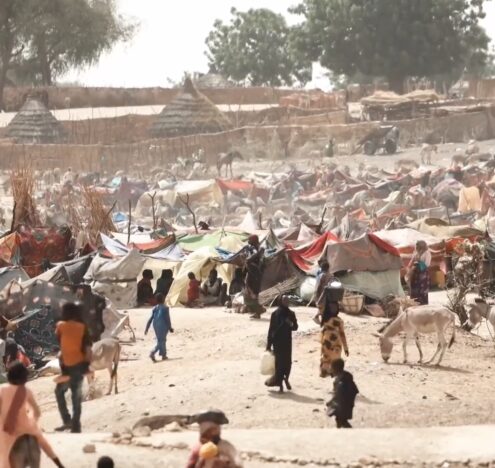“We Didn’t Start the Fire” is a new column in collaboration with Foreign Policy for America’s NextGen network, a premier group of next generation foreign policy leaders committed to principled American engagement in the world. This column elevates the voices of diverse young leaders as they establish themselves as authorities in their areas of expertise and expose readers to new ideas and priorities. Here you can read about emergent perspectives, policies, risks, and opportunities that will shape the future of US foreign policy.
Though well-intentioned, the US government’s approach to the Women, Peace, and Security (WPS) agenda often falls into two traps: Obscuring the persistence, prevalence, and power of the patriarchy and homogenizing women. Including women as “meaningful participants” in conflict resolution and prevention requires grappling with the fact that terms like “women’s interests” obscure the diversity of women’s political interests and preferences. It also requires considering the potential backlash that women face when they participate in male-dominated political institutions. Working toward genuinely inclusive societies requires engaging with two concepts that often make bureaucrats uneasy: Patriarchy and intersectionality.
CONFRONTING THE PATRIARCHY
Patriarchy is the elephant in the room in many discussions about advancing women’s rights and participation in peace and security activities. Patriarchal norms produce analytical blind spots about the causes of women’s subordination and women’s agency. In the face of challenges to the status quo, patriarchal systems can re-assert themselves to maintain the gendered hierarchy. An earnest approach to fulfilling the objectives of the WPS agenda requires dealing with both of these outgrowths of patriarchy.
While policymakers and documents — such as the Women, Peace, and Security Act of 2017, the associated US Strategy on Women, Peace, and Security released in 2019, and the implementation plans various agencies released in 2020) — are comfortable identifying that women and women’s issues are subordinated globally, they are less comfortable identifying who or what is doing that subordination. Patriarchal norms also contribute to limiting depictions of women to merely victims of conflict or untapped resources for peacebuilding. These norms obscure the ways that women contribute to political violence, despite evidence that women have participated as combatants in roughly 40% of rebel groups and the myriad of non-combat ways that women have supported rebel groups, from providing food and care to fighters to mobilizing support for the cause among civilians.
Understanding patriarchy is integral to understanding the violence that prominent women face. Women’s exclusion from positions of power is not incidental and those who see women’s empowerment coming at a cost to their status may resist. The possibility of backlash to women’s advancement — which can come in various forms, including resistance to women’s empowerment and violence against women — has been documented in a number of different contexts, including the United States, Vietnam, Colombia, Cameroon, the UK, Sweden, Indonesia, Rwanda, and Bosnia-Herzegovina.
The oppressive systems that have prevented women from participating in institutions will not melt away automatically following women’s entry into the halls of power.
Because of the lack of attention that they pay to the role of patriarchal oppression, many of the programs designed to empower women fail to account for the resistance that they may face. The WPS agenda must go beyond ensuring that women have a “seat at the table.” Instead, the agenda needs to consider the violence that they may face by taking up these positions, and assess the changes in the broader political system are necessary to prevent violent backlash. While many of the indicators and objectives associated with the implementation of the WPS agenda focus on the number of women trained or the amount of support women’s groups receive, we cannot replicate an “add women and stir” approach that does not challenge patriarchal oppression. The oppressive systems that have prevented women from participating in institutions will not melt away automatically following women’s entry into the halls of power.
ENGAGING WITH INTERSECTIONALITY
An intersectional approach to understanding women’s experiences and interests is absolutely essential to effectively implementing the WPS agenda. Intersectional gender analysis provides a way for gender analysis to go beyond merely disaggregating by sex. The current homogenizing approach does not reckon with the possibility that women’s other identities (their religion, race or ethnicity, class, whether they are a member of the LGBTQ+ community, age, etc.) condition how they experience and respond to reforms, programs, and political developments. Intersectionality can help us rectify the previously discussed blindspots in our current analysis, which do not account for the wide variation in women’s activities with regards to fomenting conflict and building peace.
Many of the metrics associated with the implementation of the US WPS strategy erase the experiences, backgrounds, and identities of women in favor of using gender as an umbrella category. Consider, for example, that one of the three metrics that the State Department will use to track progress toward increasing the “meaningful participation of women around the world in decision-making processes related to conflicts and crises successful implementation” is the “number of women who participate in US-funded training for foreign nationals.” Such metrics do not incentivize ensuring that these trainings include a diverse set of women; the inclusion of women itself seems to be sufficient to check the diversity box. While women may share certain experiences by dint of their gender, an inclusion strategy that suggests that any woman can represent all women is one that is set up to fail. An intersectional approach, which considers how gender interacts with other relevant identity characteristics like class, race, ethnicity, and religion is imperative to implementing effective and inclusive programs.
A PATH FORWARD
Advancing women’s rights globally is a laudable and important objective. Yet, the current framework for promoting women’s participation in matters of peace and security has fatal blindspots. Integrating gender analysis and women into peace and security institutions cannot be done in a manner that assumes that women’s interests and experiences are homogenous and that their historical exclusion is a coincidence on a grand scale. Taking seriously the patriarchal systems we live under and adopting an intersectional lens are integral steps for the WPS Agenda as it moves forward.
In practice, this will mean considering the threats that women who enter male-dominated spaces like politics, security, and peacebuilding face. Simply encouraging women to participate, without providing them with the support (be it financial, social, or physical) they need to weather possible backlash and violence can render women vulnerable. Adopting an intersectional approach will require revising both our analytical lens and the metrics by which we gauge progress. Gender analysis should go beyond merely differentiating between men and women, to examine how different US policies and programs are likely to impact different categories of women (considering, for example, how race, ethnicity, class, age, and religion intersect with gender to produce unique experiences and interests) and how women’s identities shape their role in conflict and peacebuilding. Metrics that incentivize policymakers and implementing partners to recruit participants from a variety of backgrounds and identity groups and adopting metrics that consider how gender norms and intersectional identities also shape men’s activities, would be two means of incorporating intersectionality into the US approach to women, peace, and security.
Though the US has made commendable strides toward recognizing the role that women play in conflict dynamics and peacebuilding, the current strategy’s unwillingness to engage with women’s lived experiences undermines earnest efforts to meaningfully include women.
Hilary Matfess is an Assistant Professor at the Josef Korbel School at the University of Denver, where her research focuses on gender and political violence.





















